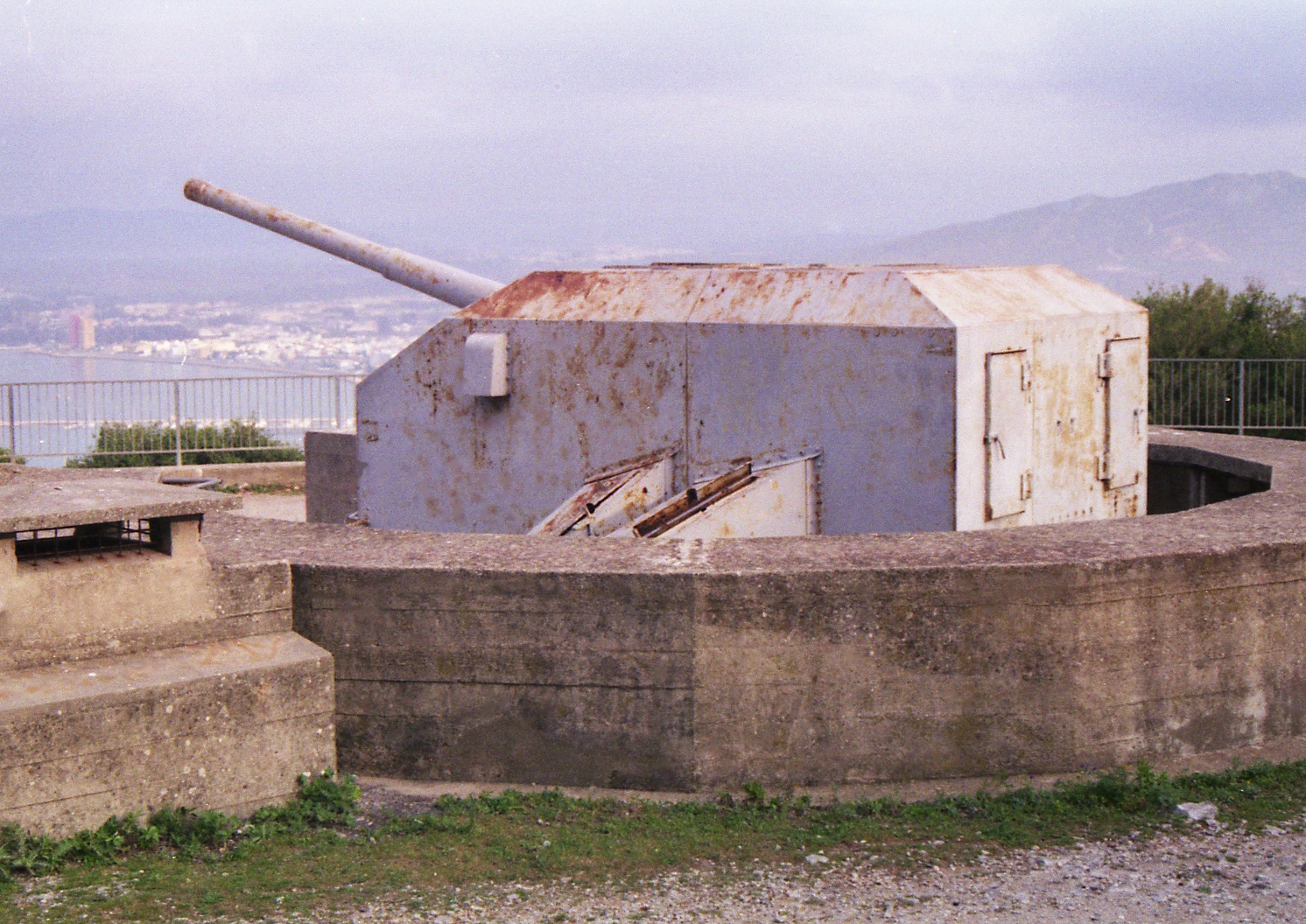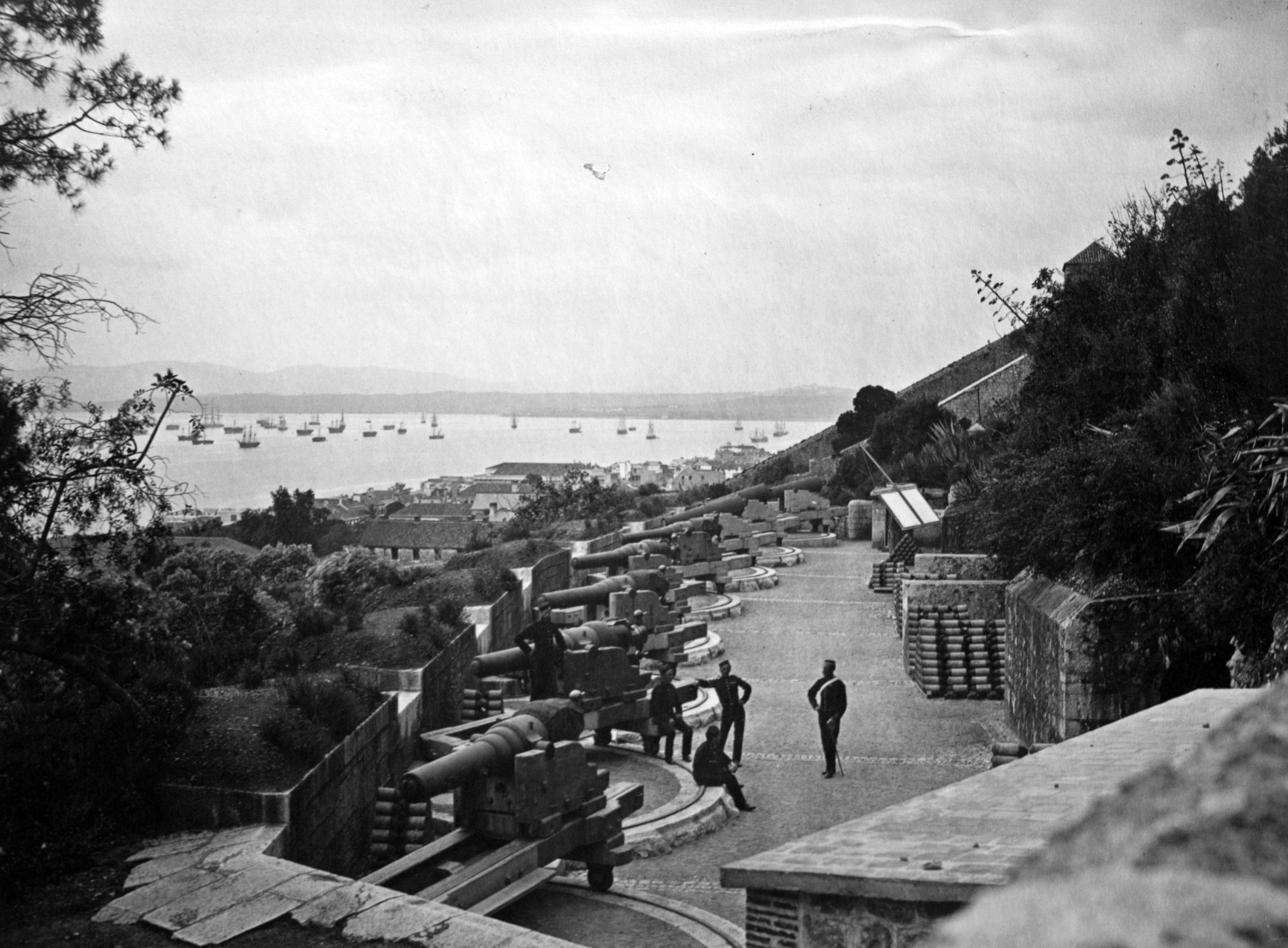|
Raglan's Battery
Raglan's Battery was an artillery battery overlooking the harbour in the British Overseas Territory of Gibraltar. During World War II the Raglan Battery Shelter was here. Description Raglan's Battery was one of the first set of retired batteries which were proposed by General Sir John Jones. These "retired" batteries were the first to be set away from the shoreline in order that they could get greater range by taking advantage of the increased altitude of the Rock of Gibraltar. In addition, the batteries were more difficult for the enemy to spot. Jones also recommended similar batteries at the Civil Hospital and the Jones' Battery. These must have been a success as a further set were constructed which included Gardiner's Battery Gardiner's Battery is an artillery battery in the British Overseas Territory of Gibraltar. It is named after the governor Sir Robert Gardiner. Description Gardiner's Battery was part of a second set of retired batteries which were proposed by Ge ... ... [...More Info...] [...Related Items...] OR: [Wikipedia] [Google] [Baidu] |
Fortifications Of Gibraltar
The Gibraltar peninsula, located at the far southern end of Iberia, has great strategic importance as a result of its position by the Strait of Gibraltar where the Mediterranean Sea meets the Atlantic Ocean. It has repeatedly been contested between European and North African powers and has endured fourteen sieges since it was first settled in the 11th century. The peninsula's occupants – Moors, Spanish, and British – have built successive layers of fortifications and defences including walls, bastions, casemates, gun batteries, magazines, tunnels and galleries. At their peak in 1865, the fortifications housed around 681 guns mounted in 110 batteries and positions, guarding all land and sea approaches to Gibraltar. Hughes & Migos, p. 91 The fortifications continued to be in military use until as late as the 1970s and by the time tunnelling ceased in the late 1960s, over of galleries had been dug in an area of only . Gibraltar's fortifications are clustered in three main a ... [...More Info...] [...Related Items...] OR: [Wikipedia] [Google] [Baidu] |
Gibraltar
) , anthem = " God Save the King" , song = " Gibraltar Anthem" , image_map = Gibraltar location in Europe.svg , map_alt = Location of Gibraltar in Europe , map_caption = United Kingdom shown in pale green , mapsize = , image_map2 = Gibraltar map-en-edit2.svg , map_alt2 = Map of Gibraltar , map_caption2 = Map of Gibraltar , mapsize2 = , subdivision_type = Sovereign state , subdivision_name = , established_title = British capture , established_date = 4 August 1704 , established_title2 = , established_date2 = 11 April 1713 , established_title3 = National Day , established_date3 = 10 September 1967 , established_title4 = Accession to EEC , established_date4 = 1 January 1973 , established_title5 = Withdrawal from the EU , established_date5 = 31 January 2020 , official_languages = English , languages_type = Spoken languages , languages = , capital = Westside, Gibraltar (de facto) , coordinates = , largest_settlement_type = largest district , l ... [...More Info...] [...Related Items...] OR: [Wikipedia] [Google] [Baidu] |
Artillery Battery
In military organizations, an artillery battery is a unit or multiple systems of artillery, mortar systems, rocket artillery, multiple rocket launchers, surface-to-surface missiles, ballistic missiles, cruise missiles, etc., so grouped to facilitate better battlefield communication and command and control, as well as to provide dispersion for its constituent gunnery crews and their systems. The term is also used in a naval context to describe groups of guns on warships. Land usage Historically the term "battery" referred to a cluster of cannon in action as a group, either in a temporary field position during a battle or at the siege of a fortress or a city. Such batteries could be a mixture of cannon, howitzer, or mortar types. A siege could involve many batteries at different sites around the besieged place. The term also came to be used for a group of cannon in a fixed fortification, for coastal or frontier defence. During the 18th century "battery" began to be used as a ... [...More Info...] [...Related Items...] OR: [Wikipedia] [Google] [Baidu] |
Ministry Of Defence (United Kingdom)
The Ministry of Defence (MOD or MoD) is the department responsible for implementing the defence policy set by His Majesty's Government, and is the headquarters of the British Armed Forces. The MOD states that its principal objectives are to defend the United Kingdom of Great Britain and Northern Ireland and its interests and to strengthen international peace and stability. The MOD also manages day-to-day running of the armed forces, contingency planning and defence procurement. The expenditure, administration and policy of the MOD are scrutinised by the Defence Select Committee, except for Defence Intelligence which instead falls under the Intelligence and Security Committee of Parliament. History During the 1920s and 1930s, British civil servants and politicians, looking back at the performance of the state during the First World War, concluded that there was a need for greater co-ordination between the three services that made up the armed forces of the United Kingdom: t ... [...More Info...] [...Related Items...] OR: [Wikipedia] [Google] [Baidu] |
Artillery Battery
In military organizations, an artillery battery is a unit or multiple systems of artillery, mortar systems, rocket artillery, multiple rocket launchers, surface-to-surface missiles, ballistic missiles, cruise missiles, etc., so grouped to facilitate better battlefield communication and command and control, as well as to provide dispersion for its constituent gunnery crews and their systems. The term is also used in a naval context to describe groups of guns on warships. Land usage Historically the term "battery" referred to a cluster of cannon in action as a group, either in a temporary field position during a battle or at the siege of a fortress or a city. Such batteries could be a mixture of cannon, howitzer, or mortar types. A siege could involve many batteries at different sites around the besieged place. The term also came to be used for a group of cannon in a fixed fortification, for coastal or frontier defence. During the 18th century "battery" began to be used as a ... [...More Info...] [...Related Items...] OR: [Wikipedia] [Google] [Baidu] |
Gibraltar Harbour
The Port of Gibraltar, also known as Gibraltar Harbour, is a seaport in the British Overseas Territory of Gibraltar. It was a strategically important location during the Napoleonic Wars and after 1869 served as a supply point for ships travelling to British Raj, India through the Suez Canal. The harbour of Gibraltar was transformed in the nineteenth century as part of the British Government's policy of enabling the Royal Navy to defeat its next two largest rival navies combined. Both Gibraltar and Malta were to be made torpedo proof, and as a result the North Mole, Gibraltar Harbour, North and South Mole, Gibraltar Harbour, South Mole were extended and the Detached Mole, Gibraltar Harbour, Detached Mole was constructed. Three large dry docks were constructed and plans were available by 1894. Over 2,000 men were required and had to be billeted in old ships which had not been required since convict labour was abandoned. The demand for stone and sand necessitated building the Admiralt ... [...More Info...] [...Related Items...] OR: [Wikipedia] [Google] [Baidu] |
British Overseas Territories
The British Overseas Territories (BOTs), also known as the United Kingdom Overseas Territories (UKOTs), are fourteen dependent territory, territories with a constitutional and historical link with the United Kingdom. They are the last remnants of the former British Empire and do not form part of the United Kingdom itself. The permanently inhabited territories are internally Self-governance, self-governing, with the United Kingdom retaining responsibility for Defence (military), defence and foreign relations. Three of the territories are inhabited only by a transitory population of military or scientific personnel. All but one of the rest are listed by the Special Committee on Decolonization, UN Special Committee on Decolonization as United Nations list of non-self-governing territories, non-self-governing territories. All fourteen have the Monarchy of the United Kingdom, British monarch as head of state. three territories (the Falkland Islands, Gibraltar and the Akrotiri an ... [...More Info...] [...Related Items...] OR: [Wikipedia] [Google] [Baidu] |
John Thomas Jones
Major General Sir John Thomas Jones, 1st Baronet (25 March 1783 – 26 February 1843) was a British officer in the Royal Engineers who played a leading engineering role in a number of European campaigns of the early nineteenth century. Jones was revered by the Duke of Wellington and asked to advise on fortifications including the modernisation of the defences in Gibraltar. He was also notable as an English amateur cricketer who made six first-class appearances. Biography Sir John Thomas Jones was eldest of five sons of John Jones, esq., general superintendent at Landguard Fort, Felixstowe, Suffolk, and of Cranmer Hall, Fakenham, Norfolk, by his wife Mary, daughter of John Roberts of the 29th foot. He was born at Landguard Fort on 25 March 1783. Sir Harry David Jones was his brother. He was educated at the grammar school at Ipswich, joined the Royal Military Academy, Woolwich in the spring of 1797, received a commission as second lieutenant in the Royal Engineers on 30 August 17 ... [...More Info...] [...Related Items...] OR: [Wikipedia] [Google] [Baidu] |
Rock Of Gibraltar
The Rock of Gibraltar (from the Arabic name Jabel-al-Tariq) is a monolithic limestone promontory located in the British territory of Gibraltar, near the southwestern tip of Europe on the Iberian Peninsula, and near the entrance to the Mediterranean. It is high. Most of the Rock's upper area is covered by a nature reserve, which is home to around 300 Barbary macaques. These macaques, as well as a labyrinthine network of tunnels, attract many tourists each year. The Rock of Gibraltar, one of the two traditional Pillars of Hercules, was known to the Romans as ''Mons Calpe'', the other pillar being ''Mons Abila'', either Monte Hacho or Jebel Musa on the African side of the Strait. According to ancient myths fostered by the Greeks and the Phoenicians, and later perpetuated by the Romans, the two points marked the limit to the known world, although the Phoenicians had actually sailed beyond this point into the Atlantic, both northward and southward. The Mediterranean Sea surroun ... [...More Info...] [...Related Items...] OR: [Wikipedia] [Google] [Baidu] |
Jones' Battery
Jones' Battery is one of the best preserved of the "retired" artillery battery in the British Overseas Territory of Gibraltar. It was named after Sir John Thomas Jones who once controlled the fortifications here. Description Jones' Battery is close to the Moorish Castle. It was one of the first set of retired batteries which were proposed by General Sir John Jones. Jones was an important fortifications expert well respected by military engineers. These "retired" batteries were the first to be set away from the shoreline in order that they could get increased range by taking advantage of the steep slopes of the Rock of Gibraltar. In addition the batteries location was less obvious to the enemy. Jones also built similar batteries at the Civil Hospital and at Raglan's Battery Raglan's Battery was an artillery battery overlooking the harbour in the British Overseas Territory of Gibraltar. During World War II the Raglan Battery Shelter was here. Description Raglan's Battery was on ... [...More Info...] [...Related Items...] OR: [Wikipedia] [Google] [Baidu] |
Gardiner's Battery
Gardiner's Battery is an artillery battery in the British Overseas Territory of Gibraltar. It is named after the governor Sir Robert Gardiner. Description Gardiner's Battery was part of a second set of retired batteries which were proposed by General Sir John Jones. These "retired" batteries were set away from the shoreline in order that they could get greater range by taking advantage of the increased altitude of the Rock of Gibraltar. In addition the batteries were more difficult for the enemy to spot. Jones also built similar batteries at Raglan's Battery and Jones' Battery. This high battery fired out west over the top of Victoria Battery Victoria Battery (one of two identically-named batteries named after Queen Victoria) was an artillery battery in the British Overseas Territory of Gibraltar. It was built in the 1840s on top of the earlier Princess of Wales Batteries following a r ... which was also a retired battery and both batteries fired out over the top of Saluting ... [...More Info...] [...Related Items...] OR: [Wikipedia] [Google] [Baidu] |


_(Tony_Radakin_cropped).jpg)



